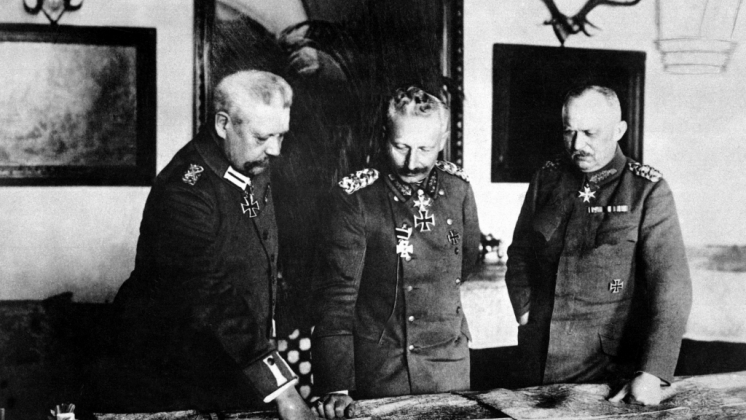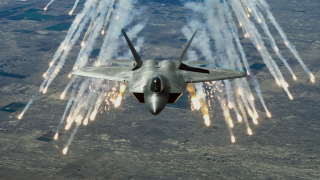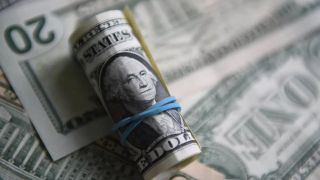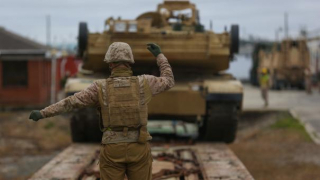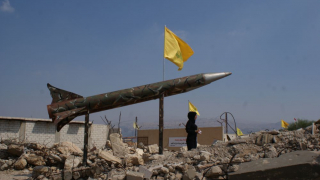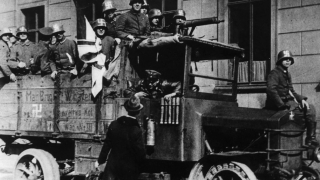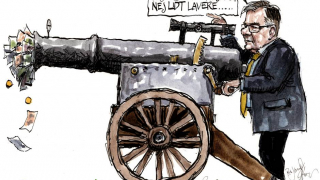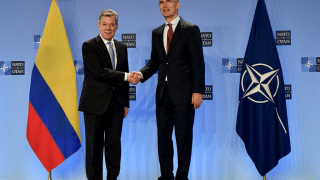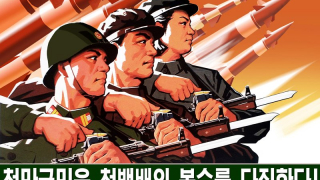The Ludendorff dictatorship's expansionism in Europe
Shortly before midday on 9 November 1923, around 3,000 far-right insurgents began marching on Munich, Germany's second largest city in the south of the country. Before these brownshirts had set out it was clear to the Nazi Party leader, the 34-year-old Corporal Adolf Hitler, that their coup d'état had already failed. A few hours prior to marching out Hitler learnt that the inter-war German Army, the Reichswehr, would firmly oppose his so-called Beer Hall Putsch. This was ordered by the Reichswehr chief, General Hans von Seeckt, who remained loyal to the Weimar Republic for now.
With impending defeat obvious Hitler had not wanted this march on Munich to go ahead, but proposed that the rebels retire to nearby Rosenheim. Hitler suggested this retreat of their forces to his famous ally, the 57-year-old Erich Ludendorff, dictator of Germany during World War One. In reaction General Ludendorff looked coldly at Corporal Hitler and exclaimed, “We march!” When Hitler said rather nervously that they “would be fired on” by Reichswehr troops or police, Ludendorff barked again, “We march!”
They marched. Ludendorff, Hitler and a few other Nazi Party officials marched at the head of the units, as they quickly reached the Marienplatz square in central Munich. A few hundred yards away at the top of Residenzstrasse, a cordon of armed police loyal to the government were awaiting the brownshirts. As they approached one Nazi Party member, Ulrich Graf, stepped forward and shouted to the police, “Don't shoot, Ludendorff and Hitler are coming!” (1). The police commander Freiherr von Godin, a conscientious officer later persecuted by the Nazis, ordered his men to fire at the rebels.
On hearing von Godin's command to shoot, the police hesitated for they could clearly see General Ludendorff at the forefront, goose-stepping in their direction. Just a few years previously, Ludendorff had issued orders to most of these police officers during the war, when they were then soldiers. Von Godin loudly repeated the order to fire, but as it was met once more with silence, the police commander grabbed a rifle from one of his men and fired it himself at the brownshirts. The other policemen followed suit. A prominent Nazi, Scheubner-Richter, marching with linked arms between Ludendorff and Hitler immediately fell dead.
If the rifle had only been fired some inches to the other side, Hitler might well have met his end – and Europe would have been spared the brutal dictatorship to come. A few Nazis shot at the police in response, but the latter showed more resolve, inflicting 16 fatalities on the brownshirts compared to four police deaths. Panic set in as the fascists dropped to the ground and fled in every direction, like earwigs disturbed from the nest.
Out of the few thousand insurgents who marched on Munich, only two of them had held their nerve. The American historian and war correspondent William L. Shirer noted that, “Ludendorff did not fling himself to the ground. Standing erect and proud in the best soldierly tradition, with his adjutant Major Streck, at his side, he marched calmly on between the muzzles of the police rifles until he reached the Odeonsplatz. He must have seemed a lonely and bizarre figure. Not one Nazi followed him. Not even the supreme leader, Adolf Hitler”. (2)
Having suffered a dislocated shoulder Hitler was instead “bundled into a little yellow Fiat on the Odeonsplatz and driven away to hiding” (3), according to the biographer of Ludendorff, Lieutenant-Colonel Donald J. Goodspeed, professor emeritus of history at Brock University, Ontario.
Lt. Col. Goodspeed acknowledged that as the unarmed Ludendorff steadfastly approached the line of policemen and “brushed them contemptuously aside”, that also “he was, in fact, marching out of history. All the rest of his life was excruciating anti-climax. Perhaps after all, it would have been better if von Godin's men had dared to shoot their wartime leader down”. (4)
How quickly fortunes change. Less than six years before, as Germany's military autocrat, Ludendorff ruled over much of Europe and came tantalisingly close to winning the First World War. During the Germans' major spring offensive, which was Ludendorff's creation, by late March 1918 the German 18th Army had captured the town of Montdidier, less than 65 miles from Paris.
The 18th Army was meeting little opposition, and it looked likely that the French capital would soon fall. In addition, German railway guns produced by the Krupp steel company, such as the 43 ton “Big Bertha”, were ominously lining up near Montdidier. German soldiers quickly loaded these siege howitzers with their 16.5 inch shells, which were then pointed southwards at Paris and fired (5). Horrified Parisiens could see the shells of Big Bertha soaring through the air, and smashing into the buildings of the landmark city.
The experienced French commander Philippe Pétain, seldom the most high-spirited of men, gloomily informed his British counterpart, Douglas Haig, that he would have to relocate French Army reserves south-west, in a desperate attempt to save Paris. This was the equivalent of saying that France would have to abandon their British ally further north.
On 24 March 1918, the Germans had already driven a deep wedge between the French and British forces south of the Somme – but, in the end, the Allied commanders need not have worried too much, for the German advance gradually petered out. The German Army of 1918, though still formidable, was not quite as good as its 1914 or 1916 predecessors, failing to capitalise on the progress made while Allied resistance hardened. From April 1918, a quarter of a million American troops were landing on French soil each month, another factor in the turning of the tide.
Yet credit must be given where credit is due. The fact that Germany, against daunting odds, had fallen just shy of victory in a conflict where they had faced the world's strongest nations (Russia, Britain, France and finally America), was largely down to Ludendorff's “outstanding military talent”, as outlined by Lt. Col. Goodspeed. He continued that, “The defensive and offensive doctrines developed under his direction displayed a tactical brilliance not shown elsewhere in the war, and seldom equalled in any war... Ludendorff's administrative ability was even more pronounced, and he must be ranked as one of the very greatest military organisers of all time”. (6)
Today Ludendorff's name is often classed in equal terms with Field Marshal Paul von Hindenburg, a tall, well-built man who possessed strong nerves and simple optimism. Yet Goodspeed discerned correctly that in comparison, “Ludendorff was a much stronger personality and much more intelligent”. For most of the war Hindenburg played a somewhat passive role, leaving the key and complex details for Ludendorff to iron out, including political matters, which Hindenburg had little time for. By the autumn of 1916, with Ludendorff having amassed virtually all real power in Germany, Kaiser Wilhelm II was merely a ceremonial figurehead. The Kaiser never did relish his meetings with the overbearing “Sergeant-Major”, as he dubbed Ludendorff.
The Ludendorff dictatorship can most plausibly be described as a milder version to that of Hitler's. The younger fanatics who emerge are usually worse than their elders, and Hitler was undoubtedly more extreme than Ludendorff by a considerable margin. While the general pursued imperialist policies as Germany's warlord, he refrained from initiating wanton acts of annihilation against the Russian-led armies, nor against Slavic civilians. Though Ludendorff could be heard making anti-Semitic comments during the war, there is no evidence to suggest that he considered executing criminal acts against Europe's Jewish populations, let alone genocide.
In fact at a conference at General Headquarters, on 14 August 1918, Ludendorff requested a “more vigorous conscription of the young Jews, hitherto left pretty much alone” (7). He held out hope, unrealistically, that Poland would dispense with armed divisions to bolster Germany's forces. These attitudes would have been unthinkable in Hitler's Germany.
Four weeks into the conflict, on 23 August 1914 Ludendorff and Hindenburg – having achieved a significant success at the fortress city of Liège in Belgium – were transferred to the Eastern front, in order to rescue a potentially dire situation against the Russian Empire's huge armies. They were threatening not only the whole of East Prussia, but had a conceivable chance to march on to Berlin itself, thereby bringing the war to an early end. In the coming months with Ludendorff's arrival, assisted by his able deputy Lt. Col. Max Hoffmann, German forces would instead force the Tsar to retreat. The Germans secured decisive early victories against the Russians, such as in the Battle of Tannenberg and around the Masurian Lakes of Central Europe.
Come the spring of 1915, the Germans had conquered a large swathe of territory in the East, and were inflicting horrendous casualties on the Russian divisions. After just over a year of war, by September 1915 the Russians had lost 1,750,000 men. (8)
Before the age of Blitzkrieg, the rapidity of German advances in the East were “made possible only because Ludendorff paid the closest attention to prosaic administrative details” (9). He set the road-mending companies feverishly to work, while he ordered that the broad Russian railway line gauge be changed to the narrower German gauge. This enabled the swift transfer of German soldiers and materiel to the Eastern front. World War One was in many ways a railway war. It had created a constant necessity for lumber, railway sleepers and cellulose. Ludendorff therefore established forestry inspectorates and saw-mills to help cope with the demand.
After less than 18 months of fighting, the German Army had captured land areas such as all of Lithuania, Courland (western Latvia), Suwalki and Bialystok (both in northern Poland), and Grodno (western Belarus). Ludendorff poured over his map at headquarters with satisfaction, and he divided these conquered areas into separate districts under German rule. He formed a police corps and law courts with provincial appeals, along with a high court of appeal founded in Kovno (central Lithuania), where Ludendorff and Hindenburg settled down in new headquarters from October 1915.
Ludendorff issued local coinages and levied taxes and customs duties (10). In the opposite manner to present day neoliberalism, he controlled big business at home and in the captured territories. Ludendorff nationalised industries en masse and brought them under his domain, roughly brushing aside the arguments of corporate managers who came to see him. Hindenburg, a massive and intimidating presence, nodded approvingly and grunted in his deep voice to support his colleague's views.
Goodspeed wrote that, “Ludendorff was at least as brilliant an administrator as a soldier, and he thoroughly enjoyed using his powers. More ambitiously than Napoleon, he dreamed of the future colonisation of the East, especially of Courland... Ludendorff, determined that Germany would get everything possible out of the occupied territories, administered them with a ruthless hand”.
Further power was drawn to Ludendorff as he created monopolies on cigarettes, alcohol, especially spirits, salt, matches and confectionery. He founded a chain of newspapers and placed them under strict censorship, which forced upon the local populations the news that he wanted them to read (11). Ludendorff established factories for the manufacture of barbed wire, and erected workshops for the repair of military equipment.
Large caches of captured Russian machine-guns were altered to take German ammunition. Billets were constructed for the German troops, better quality hospital facilities were built, winter clothing was provided; and other measures were adopted to maintain the health of the German Army's soldiers and its horses. Leave was arranged and the mail delivery system put in order to reach standards of German efficiency.
To sustain morale Ludendorff created soldiers' clubs, libraries, bookshops and concerts. He intensified military training and tweaked it to incorporate lessons learnt during the war. Supply services were improved, and the roads were made fit for all-weather transport, including mechanised machinery and horses. Ludendorff saw to it that Germany was furnished with ample quantities of Polish scrap-iron, brass, copper, skins and hides. The German Army was heavily reliant on the horse, and there was an ongoing shortage of these once sought after animals. He implacably ordered that horses be conscripted from farmers and peasants, despite the hardship this brought on the people in occupied regions.
In particular, Ludendorff commandeered the Lithuanian horse which he wrote “possesses great powers of endurance” and is “a very useful animal for military purposes”; though the general admitted of Lithuania itself, “The country was bound to suffer severely as the result of the continuous heavy demands made upon it, especially the constant levies of horses and cattle. The local administrative authorities often drew my attention to this fact, but there was nothing for it but to insist on these deliveries”. (12)
Ludendorff ruthlessly enacted tight controls over agriculture in the conquered regions, and he dispatched motor-ploughs, agricultural machinery and seed from Germany to augment food crops. German companies were established to farm the colonised areas, while a census was taken of peasants' cattle.
From the war's outset, Ludendorff spoke bluntly about his desire “of a greater Fatherland and of territorial acquisitions that would compensate the German people for their sacrifices”. His view was that “if Germany makes peace without profit, Germany has lost the war” (13). For these reasons Ludendorff began to enjoy “a tremendous reputation with the masses of the German people”, along with Hindenburg. (14)
On 11 September 1917 at a Crown Council meeting in Pless Castle, Silesia, Ludendorff demanded that “the conquered territories in the East be divided into a Duchy of Courland and a Grand Duchy of Lithuania”. These annexed lands would ostensibly be placed under the personal sovereignty of the Kaiser.
Ludendorff's hegemonic aspirations for the West were likewise exacting. Once victory was obtained, far from his considering the returning of Alsace-Lorraine to France or offering concessions on it, he intended that these provinces be fully incorporated into Prussia, rather than administered as a separate entity. Ludendorff had plans for the seizure of all French property in Alsace-Lorraine, which he wanted to hand over to German war veterans as compensation for their sacrifices to Germany. He wanted economic union with Belgium, and a prolonged military occupation of that country.
In late 1917, as Germany's eastern forces were preparing to give the coup de grâce to the Tsar's regime, Ludendorff increased his demands against the Kremlin. His final peace terms to Russia were harsh and audacious in scope, and he was becoming impatient with how long the negotiations were taking. To show how serious he was, Ludendorff ordered German soldiers to march deep into eastern Europe during the early spring of 1918 – which they did, almost unmolested. Ludendorff was firmly set on carving out a great slice of Russia's Empire, to be absorbed into the German Reich: A land mass stretching from the Baltic to the Black Sea, hundreds of miles of fertile, resource rich land.
These expansionist goals were supported strongly by Field Marshal Hindenburg. He and Ludendorff rarely disagreed on anything, hence their seamless collaboration. On 19 December 1917 Hindenburg informed the German foreign secretary, Richard von Kühlmann, that Germany needed the Baltic territories “for the manoeuvring of my left wing in the next war”. (15)
As further humiliation for Russia, and to demonstrate his contempt for the Bolsheviks, Ludendorff granted Finland, Poland and the Ukraine their independence – all formerly part of the Russian Empire – while Estonia and Latvia were to be occupied by the German Army. Also stripped from the Kremlin were the Black Sea port of Batumi and Kars Oblast. Ludendorff turned his ire towards Romania too. He insisted that Romania be turned into a German satellite under a puppet regime, partly as retribution for the Romanians having unexpectedly chosen to join the Allied side in August 1916.
Notes
1 David King, The Trial of Adolf Hitler: The Beer Hall Putsch and the Rise of Nazi Germany (Pan; Main Market edition, 14 June 2019) Chapter 20, Blood Land
2 William L. Shirer, The Rise and Fall of the Third Reich: A History of Nazi Germany (Fawcett Crest Book, 1 Jan. 1968) p. 74
3 Donald J. Goodspeed, Ludendorff: Soldier: Dictator: Revolutionary (Hart-Davis; 1st edition, 1 Jan. 1966) p. 242
4 Goodspeed, Ludendorff, p. 243
5 Washington Post, “A Blast from 'Big Bertha'”, 24 March 1999
7 Ibid., p. 209
8 Ibid., p. 136
9 Ibid., p. 103
10 Ibid., p. 138
11 Ibid.
12 Erich Ludendorff, Ludendorff's Own Story, August 1914-November 1918, The Great War (Pickle Partners Publishing, 12 Apr. 2012) Chapter 6, The Headquarters of the Commander-in-Chief on the Eastern front in Kovno
13 Will Brownell, Denise Drace-Brownell, Alex Rovt, The First Nazi: Erich Ludendorff (Counterpoint, 31 Mar. 2016) Chapter 7, Ludendorff fights Lenin
14 Goodspeed, Ludendorff, p. 236
15 James Joll, Gordon Martel, The Origins of the First World War (Routledge; 3rd edition, 5 Oct. 2006) p. 212

